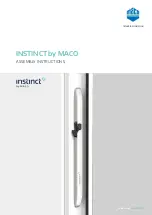
© Leuze electronic GmbH + Co. KG, In der Braike 1, 73277 Owen, Germany, Phone: +49 (0) 7021/573-0, Fax: -199, [email protected], www.leuze.com We reserve the right to make changes 2015/11 Art. no. 50130051
L300 Safety Locking Devices
1 INFORMATION ON THIS DOCUMENT
1.1 Function
The present instruction sheet provides information on installation, connection and safe
use of the L300 series safety switch having an interlocking function with or without
guard locking, according to the EN ISO 14119 standard.
1.2 Addressed to: qualifi ed personnel only
The operations you fi nd explained in the present instruction sheet must exclusively
be carried out by qualifi ed personnel, who are perfectly able to understand them and
have been duly authorised.
1.3 Original instructions
This document contains the original instructions.
2 SYMBOLS USED
This symbol indicates any relevant complementary information.
Warning: Any failure to observe this warning note can cause breakage or
malfunction, with possible loss of the safety function.
3 FITTING INSTRUCTIONS
3.1 Choosing the type of actuator
Warning
: The switch is available with two types of RFID actuator: one with
a high coding level (UCA) and one with a low coding level (SCA). In the case
where an actuator with a low coding level has been chosen, ensure that the
additional specifi cations prescribed in paragraph 7.2 of the EN ISO 14119:2013
standard are respected during installation. Moreover, any other SCA actuators
present in the same place where the switch has been installed must be segregated
and kept under strict control in order to avoid any manipulation of the safety device.
It is advisable to use actuators with a high coding level so as to make the
installation safer and more fl exible. This will render it unnecessary to screen
the device, to fi t it in non-accessible areas or to follow other prescriptions specifi ed
by the EN ISO 14119 standard for actuators with low coding level.
3.2 Choosing the operating principle
Warning
:The switch is available with two operation principles:
Operation principle SLM24 = Actuator locked with electromagnet de-
energised
(spring lock, release with I4 input activation).
Operation principle MLM24 = Actuator locked with electromagnet energised
(lock with l4 input activation, spring release).
Operation principle SLM24 keeps the door lock even in the case where the machine
is disconnected from the power supply. Therefore, if the machine is subject
to dangerous movements with inertia, all dangerous elements are made fully
inaccessible (door locked) even in case of sudden power failure. On the contrary, if
the machine structure allows a person to enter the danger area with the whole body
and possibly end up being stuck inside the machine, the switch must be provided
with an anti-panic release button, in order to allow the trapped person to get out
even in case of power failure.
Operation principle MLM24 keeps the door lock only when the machine is connected
to the power supply. Therefore, before choosing this operation principle, carefully
evaluate all dangers deriving from sudden power failure with a consequent possible
immediate door release.
In case of machines without inertia, i.e. with dangerous elements being
immediately blocked as soon as the protection is opened, for which a door-
lock switch has been chosen merely to safeguard the production process, operation
principle SLM24 or MLM24 can be used indifferently.
3.3 Choosing the safety output activation mode
Warning: The switch is available with two safety output activation mode:
- Mode 1 (L300-Mx1x): safety output active on guard closed and locked
- Mode 2 (L300-Mx2x): safety output active on guard closed.
When the switch and the actuator are correctly mounted on the guard, a Mode 1
switch will activate safety output OSSDs when the guard is both closed and the lock-
ing bolt is in the locked position, so the guard cannot be opened with safety outputs
on. Mode 1 device is a coded type 4 guard locking with lock following EN ISO 14119.
When the switch and the actuator are correctly mounted on the guard, a Mode 2
switch will activate safety output OSSDs when the guard is closed. This mode allows
to lock/unlock the guard while still keeping on the safety chain, typically for specifi c
applications without inertia, when the risk does not continue after the opening of the
guard. Care must be taken to evaluate if Mode 2 could be applied safely to the machin-
ery to be protected: Mode 2 device is a high coded type
4 guard locking without lock following EN ISO 14119.
3.4 Device adjustment
If necessary, it is possible to adjust the position of the
head and the release device (if present) in order to turn
the device to the most appropriate position for the spe-
cifi c application. Fully remove the 4 screws from the
head to turn either the head or the release device inde-
pendently over an arc of 270°.
Warning
: Do not force the rotation beyond 270°, otherwise the device could
be broken.
Once the adjustment has been completed, newly tighten the head screws with a
torque from 0.8 to 1.2 Nm.
Warning
: In order to implement Safety function number 4 (see par. 4.1) after
head adjustment it is mandatory to fasten the two provided one-way screws
in place of two original screws, in opposite corner positions.
3.5 Device adjustment
Warning
: The device must be fi xed to the
machine by means of 4 M5 screws (not
supplied) with a length of 45 mm or more. The
device must never be fi xed with less than 4 screws.
The 4 screws chosen for fi xing must be able to
withstand a pull greater than 20,000 N exerted on
the actuator.
Tightening torque of the 4 M5 screws from 2 ... 3 Nm
It is advisable to install the device in the top
part of the door, in order to prevent any dirt or
work residues from getting inside the hole where the
actuator is to be introduced. In order to avoid device
bypassing it is advisable to fi x the device to the
machine body with non-removable fastening.
3.6 Fixing the actuator to the door
Warning
:
As prescribed by the
EN ISO 14119 standard, the actuator
must be fi xed to the door frame irremovably.
For this purpose the actuator is provided with
4 safety screws (Bits for safety screws Torx TR25).
After the fi xing operation, it is mandatory to plug
the holes of the 4 screws using the caps supplied,
so that it becomes more diffi cult to access the
screws.
The actuator must always be fi xed using at least 4 M5 screws with a length of
20 mm or more. The actuator must never be fi xed with less than 4 screws. The 4
screws chosen for fi xing (if different from those supplied) must be able to withstand
a pull greater than 20,000 N exerted on the actuator.
Tightening torque of the 4 M5 screws = 2 ... 3 Nm
For correct fi xing, other means can also be used, such as rivets, non-
removable one-way security screws or other equivalent fi xing system, as long
as they are able to withstand a pulling force greater than 20,000 N.
3.7 Switch-actuator alignment
Warning
: Despite the fact that the device has been designed to help
alignment between the head and the respective actuator, excessive
misalignment could cause the actuator to be damaged. Periodically check the
alignment between the switch and the respective actuator.
Maximum misalignment permitted from the hole axis, for rigid doors: +/-2 mm
vertical and horizontal.
The actuator must not hit the outside of the actuator inlet area, and must not be
used as a centering device for the mobile protection.
In the case of application on swing doors, check that the radius between the axis of
the actuator pin and the axis of the hinge fi tted on the door is greater than 150 mm.
Do not use a hammer for the adjustments, unscrew the screws and adjust the
device manually, then tighten it in position.
This device is not suitable for applications in which the guard, with the permanently
attached actuator, allows misalignments such as the actuator shaft does not enter
through the hole of the device head with the door completely closed.
The switch is provided with a through hole for inserting the actuator. In the
case where it is used in dusty places, make sure not to obstruct the outlet
hole opposite the inlet one. This way, any dust which may go inside the hole will
always be allowed to come out of the opposite side.
























